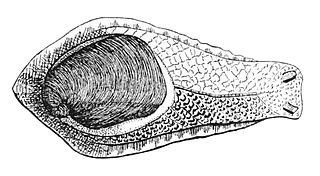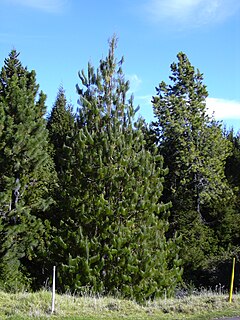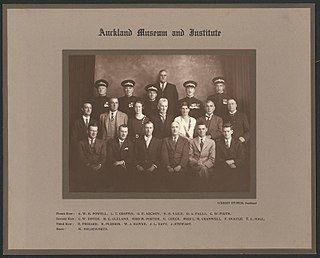
Kiwi are flightless birds endemic to New Zealand of the genus Apteryx and family Apterygidae. Approximately the size of a domestic chicken, kiwi are by far the smallest living ratites.

Moa are an extinct group of flightless birds formerly endemic to New Zealand. There were nine species. The two largest species, Dinornis robustus and Dinornis novaezelandiae, reached about 3.6 m (12 ft) in height with neck outstretched, and weighed about 230 kg (510 lb) while the smallest, the bush moa, was around the size of a turkey. Estimates of the moa population when Polynesians settled New Zealand circa 1300 vary between 58,000 and approximately 2.5 million.

Powelliphanta is a genus of large, air-breathing land snails, pulmonate gastropods in the family Rhytididae, found only in New Zealand. They are carnivorous, eating invertebrates, mostly native earthworms. Often restricted to very small areas of moist forest, they are prey to introduced mammalian predators, and many species are threatened or endangered.

The great spotted kiwi, great grey kiwi or roroa is a species of kiwi endemic to the South Island of New Zealand. The great spotted kiwi, as a member of the ratites, is flightless. It is the largest of the kiwi. The rugged topography and harsh climate of the high altitude alpine part of its habitat render it inhospitable to a number of introduced mammalian predators, which include dogs, ferrets, cats, and stoats. Because of this, populations of this species have been less seriously affected by the predations of these invasive species compared to other kiwi. Nonetheless, there has been a 43% decline in population in the past 45 years, due to these predators and habitat destruction. This has led it to be classified as vulnerable. There are less than 16,000 great spotted kiwis in total, almost all in the more mountainous parts of northwest Nelson, the northwest coast, and the Southern Alps. A minority live on island reserves.

Captain Frederick Wollaston Hutton was an English-New Zealand scientist who applied the theory of natural selection to explain the origins and nature of the natural history of New Zealand. An army officer in early life, he then had an academic career in geology and biology. He became one of the most able and prolific nineteenth century naturalists of New Zealand.

Rhytididae is a taxonomic family of medium-sized predatory air-breathing land snails, carnivorous terrestrial pulmonate gastropod molluscs in the superfamily Rhytidoidea.

Schizoglossa, common name the Paua slugs, is a genus of medium-sized to large predatory, air-breathing, land slugs, carnivorous terrestrial pulmonate gastropod molluscs in the family Rhytididae. They are currently classified by the New Zealand Department of Conservation as Nationally Vulnerable.

Wainuia is a genus of air-breathing predatory land snails, terrestrial pulmonate gastropod molluscs in the family Rhytididae. Species in this genus occur in New Zealand.

Wainuia urnula is a species of air-breathing predatory land snail, a terrestrial pulmonate gastropod mollusc in the family Rhytididae.

Rhytida is a genus of medium-sized, air-breathing, predatory land snails, terrestrial pulmonate gastropod molluscs in the family Rhytididae.

Powelliphanta rossiana, known as Ross' land snail, is a species of large, carnivorous land snail, a terrestrial pulmonate gastropod mollusc in the family Rhytididae. This species is endemic to the South Island of New Zealand. Subspecies include:

Powelliphanta lignaria, known as one of the amber snails, is a species of large, carnivorous land snail, a terrestrial pulmonate gastropod mollusc in the family Rhytididae. The eggs of P. lignaria are oval and seldom constant in dimensions 10 × 8.25, 9 × 7.75, 9 × 8, 8.75 × 7.75 mm.

Rhytida australis is a species of small, air-breathing land snail, a terrestrial pulmonate gastropod mollusc in the family Rhytididae.
Rhytida meesoni is a species of small, air-breathing land snail, a terrestrial pulmonate gastropod mollusc in the family Rhytididae.
Rhytida oconnori is a species of medium-sized, air-breathing land snail, a terrestrial pulmonate gastropod mollusc in the family Rhytididae. It is found only at the top of New Zealand's South Island in the Abel Tasman National Park and at Parapara Peak in Golden Bay.
Rhytida greenwoodi is a species of medium-sized, air-breathing predatory land snail, a terrestrial pulmonate gastropod mollusc in the family Rhytididae.

Pinus patula, commonly known as patula pine, spreading-leaved pine, or Mexican weeping pine, and in Spanish as pino patula or pino llorón, is a tree native to the highlands of Mexico. It grows from 24° to 18° North latitude and 1,800–2,700 m (5,900–8,900 ft) above sea level. The tree grows up to 30 m (98 ft) tall. It cannot withstand long periods of temperatures as low as −10 °C (14 °F), but resists occasional brief dips below 0 °C (32 °F). It is moderately drought-tolerant, and in this respect is superior to Pinus taeda. The average annual rainfall in its native habitat is from 750 to 2000 mm. This happens mostly in summer, but in a little area of the State of Veracruz on the Sierra Madre Oriental its habitat is rainy the year round.

Arthur William Baden Powell was a New Zealand malacologist, naturalist and palaeontologist, a major influence in the study and classification of New Zealand molluscs through much of the 20th century. He was known to his friends and family by his third name, "Baden".

Fossarina is a genus of sea snails, marine gastropod molluscs in the family Trochidae, the top shells.















